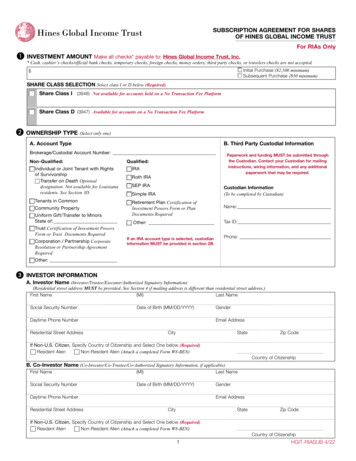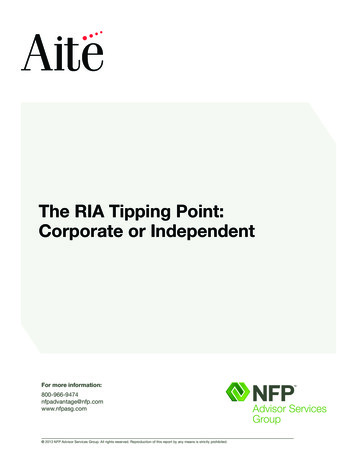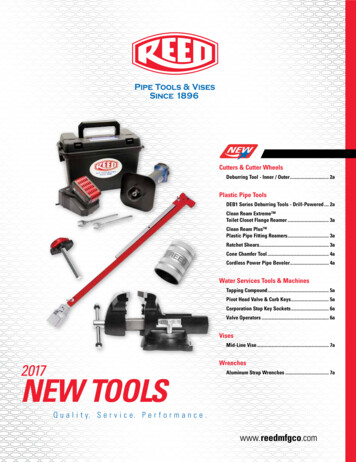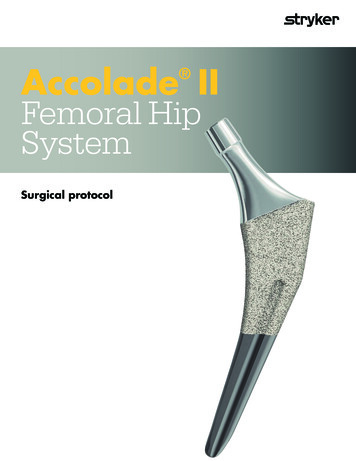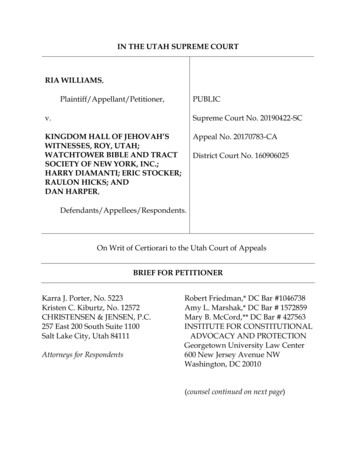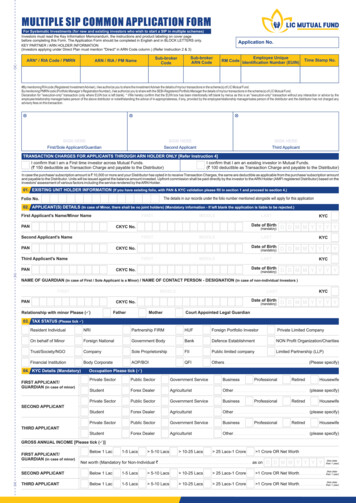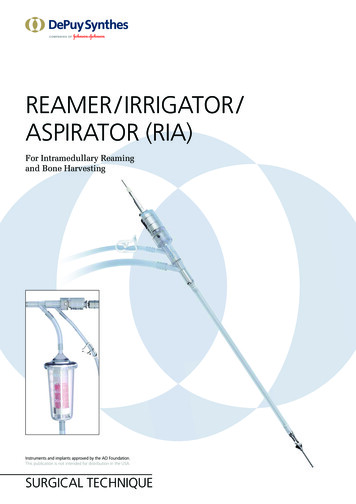
Transcription
REAMER / IRRIGATOR /ASPIRATOR (RIA)For Intramedullary Reamingand Bone HarvestingInstruments and implants approved by the AO Foundation.This publication is not intended for distribution in the USA.SURGICAL TECHNIQUE
Image intensifier controlWarningThis description alone does not provide sufficient background for direct useof DePuy Synthes products. Instruction by a surgeon experienced in handling theseproducts is highly recommended.Processing, Reprocessing, Care and MaintenanceFor general guidelines, function control and dismantling of m ulti-part instruments,as well as processing guidelines for i mplants, please contact your local salesrepresentative or refer are-maintenanceFor general information about reprocessing, care and maintenance of Synthesreusable devices, instrument trays and cases, as well as processing of Synthes nonsterile implants, please consult the Important Information leaflet (SE 023827) orrefer are-maintenance
TABLE OF CONTENTSINTRODUCTIONOverview 2Indications 4SURGICAL TECHNIQUEPreparation 5Assembly 9Reaming 18Bone Harvesting 20Disassembly 22PRODUCT INFORMATIONSingle-Patient-Use Instruments 23Other Material 25General Instruments 26Optional Instruments 28Power Equipment 30Cleaning Instruments 31RIA-Instruments Set (105.309) 31BIBLIOGRAPHY 32Reamer / Irrigator / Aspirator (RIA) Surgical TechniqueDePuy Synthes1
OVERVIEWREAMING WITH LOWERED RISKOF SYSTEMIC COMPLICATIONFAST, EFFICIENT REAMINGDesigned for: Lower intramedullary pressure1, 4, 5 Lower fat embolisation2, 3, 14 Lower heat generated11 Removal of infected tissue6, 7, 8, 13, 14 Time saving one-step procedure10 Sharp reamer heads for facilitated cuttingReamer headTube assemblyFlow of irrigating fluidBone marrow, morselized boneAUTOGRAFT HARVESTING Low morbidity7, 18 Possible range: 30 to 80 cc per procedure Well-known technique Osteoinductive and osteogenic12, 16, 17Constant cooling withirrigation fluid, alsoemulsifies reamings forevacuationSharp edges forefficient cutting2DePuy Synthes Reamer / Irrigator / Aspirator (RIA) Surgical TechniqueRemoval of marrow andbone through aspirationholes creates negativeintramedullary pressureDeep flutes toprevent clogging
Locking clipDrive shaftDrive shaft sealGravity fed irrigation intocannulation of drive shaftAspirationof bone marrowand finelymorselized boneMesh sized to capturemorselized boneand bone marrowGraft filter 100 cc capacityAspiration tubeconnected tovacuum sourceReamer / Irrigator / Aspirator (RIA) Surgical TechniqueDePuy Synthes3
INDICATIONSIntended use To clear the medullary canal of bone marrow andreaming debris To clear the medullary canal of infected bone tissue To effectively size the medullary canal for the acceptance ofan intramedullary implant or prosthesis To harvest finely morselized autogenous bone and bonemarrow for any surgical procedures that require bone graftin order to facilitate fusion and/or fill bone defects. Theseprocedures include spinal fusion, joint arthrodesis, totaljoint replacement, fracture repair, nonunion,maxillofacial reconstruction, and tumor removalNote: When deciding on bone harvesting, the patient’shistory, bone quality, physiological condition andcompliance must be taken into account.4DePuy Synthes Reamer / Irrigator / Aspirator (RIA) Surgical Technique
PREPARATION1Select appropriate length of tube assemblyInstruments314.745S RIA Tube Assembly, for RIA Drive Shaft minimum length 360 mm, for No. 314.742, sterile314.746S RIA Tube Assembly, for RIA Drive Shaft minimum length 520 mm, for No. 314.743, sterileSelect the appropriate length of the RIA tube assembly based onthe length of the canal.Length of the canalTube assemblyLess than 350 mm360 mmGreater than 350 mm520 mmReamer / Irrigator / Aspirator (RIA) Surgical TechniqueDePuy Synthes5
Preparation2Confirm reaming diameterInstrument351.717Depth Gauge for Medullary NailsTo estimate the canal diameter, position image intensifier foran AP view of the limb at the level of the isthmus. Hold theradiographic depth gauge perpendicular to the limb andoverlay the diameter tabs over the isthmus. Read the diameteron the tab that fills the canal. Repeat with a LM view.a For reaming only, choose the implant diameter. Select areamer head 1.0 mm to 1.5 mm larger than the chosenimplant diameter.b For bone harvesting only, select a reamer head 1.0 mm to1.5 mm larger than the canal diameter at the isthmus.Notes:Measure both in AP and LM view.Precaution:The distance of the depth gauge from the bone and theposition of the receiver affect the diameter measurement.Always place the depth gauge on the side of the limbclosest to the receiver. Estimate the real width as follows:Distance between depth gauge and bone 25 mm 1 mm larger reading 50 mm 2 mm larger reading 100 mm 3 mm larger reading6DePuy Synthes Reamer / Irrigator / Aspirator (RIA) Surgical Technique
3Access canal and place reaming rodInstruments393.100Universal Chuck with T-Handle352.032 SynReam Reaming Rod B 2.5 mm, short,length 950 mmGain access to the intramedullary canal using standardopening procedures and instrumentation for the chosenimplant or entry point. Reduce the fracture, if present.Attach the universal chuck with T-handle to the reaming rod.Insert the reaming rod into the canal to the physeal scar.Verify its position with the image intensifier.Note: Ensure the reaming rod is centered in the canal inboth AP and LM view.Reamer / Irrigator / Aspirator (RIA) Surgical TechniqueDePuy Synthes7
Preparation4Confirm nail length (for reaming only)Instruments351.717Depth Gauge for Medullary Nails351.719 Elongation Tube for Reaming Rods,for Depth Gauge for Medullary Nails,for Nos. 351.717 and 03.019.001Assemble the extension tube to the depth gauge.Place the depth gauge assembly over the reaming rod.Notes: The tip of the depth gauge assembly should belocated at the entry site.Precaution:Use the depth gauge only with the 950 mm reaming rod.Determine the length of the canal. Choose the length of theimplant accordingly.Note: Consider dynamization when choosing the lengthof the implant.8DePuy Synthes Reamer / Irrigator / Aspirator (RIA) Surgical Technique
ASSEMBLY1Attach reamer headInstruments352.250S –352.259SRIA Medullary Reamer Heads12.0 mm–16.5 mm, sterile352.261S –352.265SRIA Medullary Reamer Heads17.0 mm–19.0 mm, sterile314.745S RIA Tube Assembly, for RIA Drive Shaftminimum length 360 mm,for No. 314.742, sterile314.746S RIA Tube Assembly, for RIA Drive Shaftminimum length 520 mm,for No. 314.743, sterileSelect the appropriate reamer head. Insert it into thetube assembly.Note: The reamer head is attached correctly when itcan spin freely and is retained by the tube assembly.Precaution: Reamer heads are sharp. Use care whenattaching the reamer head to the tube assembly.Reamer / Irrigator / Aspirator (RIA) Surgical TechniqueDePuy Synthes9
Assembly2Attach drive shaft to tube assembly and reamer headInstruments314.742RIA Drive Shaft, length 360 mm314.743RIA Drive Shaft, length 520 mmSelect the respective length of the drive shaft. Guide the tipof the drive shaft through the RIA tube assembly.Mate the hexagonal end of the RIA drive shaft withthe hexagonal recess in the reamer head.Note: Visually check mating through theaspiration holes.Precaution: Improper assembly can result in productbreakage, which may lead to surgical delay, bonedamage, and/or adverse tissue damage.11DePuy Synthes Reamer / Irrigator / Aspirator (RIA) Surgical Technique
Note: The drive shaft is properly attached when thehex flats are not visible. The helix is also visible whenproperly attached.Precaution: Improper assembly can result in productbreakage, which may lead to surgical delay, bonedamage, and/or adverse tissue damage.Note: The drive shaft hex is properly engaged in thereamer head when the retaining groove is hidden.Precaution: Improper assembly can result in productbreakage, which may lead to surgical delay, bonedamage, and/or adverse tissue damage.RetaininggrooveReamer / Irrigator / Aspirator (RIA) Surgical TechniqueDePuy Synthes11
AssemblyPush the outer sleeve of the RIA drive shaft forward to engagethe body of the RIA tube assembly.Precaution: Improper assembly can result in productbreakage, which may lead to surgical delay, bonedamage, and/or adverse tissue damage.Note: The drive shaft is properly attached when thetan/gray plastic coupling shaft is no longer visible.Precaution: Improper assembly can result in productbreakage, which may lead to surgical delay, bonedamage, and/or adverse tissue damage.11DePuy Synthes Reamer / Irrigator / Aspirator (RIA) Surgical Technique
3Attach locking clipInstrument352.260SLocking Clip for RIA, sterileSlide the locking clip onto the assembled RIA drive shaft andtube assembly.Note: The small ridge on the inner surface of the lockingclip matches the groove between the drive shaft and thetube assembly.Rotate the locking clip until the circular notches on thelocking clip align with the corresponding buttons on thetube assembly.Button on tube assemblyReamer / Irrigator / Aspirator (RIA) Surgical TechniqueDePuy Synthes11
Assembly4Attach drive shaft sealInstrument351.718.02S Seal for RIA Drive Shaft, sterile,pack of 2 unitsAttach the drive shaft seal to the proximal end of thedrive shaft.Note: The drive shaft seal is important to retainirrigation within the cannulation of the drive shaft.5Attach drive unit with large quick couplingInstruments530.605Battery Reamer/Drill530.760 Quick Coupling for DHS/DCS TripleReamers, for Battery Power LineSelect a cannulated drive unit that will deliver 3.5 to 4.5 Nmof torque and 700 to 900 rpm (standard drill speed). Use thecannulated quick coupling to attach the drive shaft to thedrive unit.Note: Do not use a reduction drive. Drills with a torquegreater than 6 Nm must not be used. Power equipmentdesigned for reaming must not be used.11DePuy Synthes Reamer / Irrigator / Aspirator (RIA) Surgical TechniqueDrive shaft seal
6Connect irrigationInstrumentIrrigation TubeOther material1– 2 liter container of saline solution (eg, isotonic 0.9 % NaCl)Suspend a 1 or 2 liter container of saline solution orirrigating fluid approximately one meter above the level ofthe RIA assembly.Attach the end with spike on the irrigation tube to theirrigation container.Note: The clamp on the irrigation set should be closeduntil reaming begins.Reamer / Irrigator / Aspirator (RIA) Surgical TechniqueDePuy Synthes11
AssemblyConnect the opposite end of the irrigation tube to theirrigation port on the tube assembly.Note: The irrigation port is the smaller of the two portsand is indicated by an “I”.7Connect aspirationInstrumentAspiration TubeOther material2 - 5 liter suction canisterVacuum sourceConnect the aspiration tube (non-flared end) to theaspiration port on the tube assembly.Note: The aspiration port is the larger of the two portsand is indicated by an “A”.11DePuy Synthes Reamer / Irrigator / Aspirator (RIA) Surgical Technique
Alternative for bone harvestingInstrument352.229SGraft Filter for RIA, sterileConnect the graft filter to the aspiration port on thetube assembly.Connect the distal end of the graft filter to theaspiration tube.Connect the other end of the aspiration tube (flared end)to the suction canister. Connect the suction canister directlyto the vacuum source.Note: Connect the irrigation/aspiration tube directlyto the suction canister to avoid a reduction in suction.Never connect several suction canisters.Start vacuum source, if necessary.Note: Set adjustment to maximum vacuum.Reamer / Irrigator / Aspirator (RIA) Surgical TechniqueDePuy Synthes11
REAMING1Introduce RIA assembly into medullary canalGuide the reamer head over the reaming rod. The systemshould only be used with SynReam reaming rod (352.032),as described on p. 7.Open the irrigation clamp to start flow. Turn on thevacuum source.Note: Prior to insertion into patient’s limb, visually verifyflow of irrigation fluid at the tip of the reamer head.Advance the RIA assembly over the reaming rod until the aspiration holes are fully immersed into the bone. Check position on the image intensifier. A flow of blood and bonemarrow becomes visible in the aspiration tube.Notes: Flow of aspiration begins when aspiration holesare fully immersed in the bone.The irrigation/aspiration cools the reamer heads andremoves bone marrow and morselized bone from themedullary cavity. It is crucial for the properties ofthe system.Precautions: Never ream when there is no irrigation/aspiration. While not reaming, always turn off irrigation flowand vacuum (aspiration).11DePuy Synthes Reamer / Irrigator / Aspirator (RIA) Surgical TechniqueAspirationholes
2ReamCommence reaming using a gradual advancing/retractingtechnique. Slowly advance 20–30 mm and then retract50–80 mm allowing the irrigation to flow in front of reamerhead. Then advance until resistance is felt and repeat.Notes: An insufficient irrigation volume may lead toclogging. Never advance too fast to avoid clogging.Precaution:Periodically check that the reaming aspirate is flowingback via the aspiration port and tube into the suctioncanister. Stop reaming if there is no flow.After the reamer head reaches the desired depth, withdrawthe RIA assembly while maintaining rotation with the drill.Note: Reverse the drill if advancement of the reamerbecomes difficult.Reamer / Irrigator / Aspirator (RIA) Surgical TechniqueDePuy Synthes11
BONE HARVESTING1Turn off irrigation and aspirationInstrument352.229SGraft Filter for RIA, sterileStop irrigation after withdrawing the RIA assembly from thepatient. Turn off the suction or clamp the suction tubing.Disconnect the filter canister from the lid and move it to theback table.2Prepare graftHold graft filter vertically. Compress the bone graft by gentlypushing down on the plunger. Estimate the volume of bonegraft with the scale on the outer canister.22DePuy Synthes Reamer / Irrigator / Aspirator (RIA) Surgical Technique
3Remove graft from filterInvert filter vertically with the plunger in a downwardposition. Remove the inner filter from the canister.Precaution: When handling, do not hold the openingdownwards as there is a risk of dropping the graft.Hold the inner filter over an appropriate container.Invert the inner filter vertically. Push the bone graft out ofthe filter with the plunger.Reamer / Irrigator / Aspirator (RIA) Surgical TechniqueDePuy Synthes22
DISASSEMBLY1Remove drive shaftRemove and dispose of the irrigation/aspiration tube andlocking clip. Push the outer sleeve of the drive shaft towardthe body of the RIA tube assembly.Keep the outer sleeve in a forward position while withdrawingthe drive shaft from the body of the tube assembly.Remove the drive shaft from the RIA tube assembly.Note: Dispose of the tube assembly and reamer head. Remove and dispose of the drive shaft seal.22DePuy Synthes Reamer / Irrigator / Aspirator (RIA) Surgical Technique
PRODUCT INFORMATIONSINGLE-PATIENT-USE INSTRUMENTSReamer Heads Conical tip helps centralize reamer Deep flutes prevent clogging Sharp cutting edges for every case Diameters: 12 mm – 19 mm in 0.5 mm increments Stainless steel Sterile packed Attaches to RIA Tube AssembliesArticle No.Diameter(mm)Article .264S18.5352.256S15.0352.265S19.0352.257S15.5Tube Assemblies Two lengths available (attach to corresponding drive shafts) Sterile packedArticle No.Diameter (mm)314.745S360314.746S520Reamer / Irrigator / Aspirator (RIA)Surgical TechniqueDePuy Synthes23
Product InformationSingle-Patient-Use Instruments351.718.02SSeal for RIA Drive Shaft, sterile,pack of 2 units Elastomeric seal Prevents flow of irrigation fluid into drive unit Sterile packed352.229SGraft Filter for RIA, sterile Collects finely morselized bone chips and marrow Capacity: 100 cc Graduations for estimating volume Plunger for removal of graft Sterile packed352.260SLocking Clip for RIA, sterile Secures attachment between drive shaft and tube assembly Sterile packedIrrigation/Aspiration Tubes Spike on irrigation tube to connect with irrigation source Clamp on irrigation tube to control flow of irrigation fluid Aspiration tube to connect to suction canister24DePuy Synthes Reamer / Irrigator / Aspirator (RIA)Surgical Technique
Product InformationOTHER MATERIALIrrigation Fluid Bag 1–2 Liters for reaming 3 Liters minimum for harvestingSuction Canister 2 Liters minimum for reaming 3 Liters minimum for harvestingVacuum Source Wall suction or portable suctionReamer / Irrigator / Aspirator (RIA)Surgical TechniqueDePuy Synthes25
Product InformationGENERAL INSTRUMENTSArticle No.Length (mm)314.742RIA Drive Shaft, length 360 mm314.743RIA Drive Shaft, length 520 mm Made of superelastic Nitinol, an alloy of nickeland titanium Two lengths available Attaches to RIA tube assemblies351.050Tissue Protector351.717Depth Gauge for Medullary Nails351.719 Elongation Tube for Reaming Rods,for Depth Gauge for Medullary Nails,for Nos. 351.717 and 03.019.00122DePuy Synthes Reamer / Irrigator / Aspirator (RIA) Surgical Technique
393.100Universal Chuck with T-Handle352.032*SynReam Reaming Rod B 2.5 mm, short,length 950 mm*Available non-sterile or sterile packed. Add “S” to the catalogue number to ordersterile products.Reamer / Irrigator / Aspirator (RIA)Surgical TechniqueDePuy Synthes27
Product InformationOPTIONAL INSTRUMENTSOpening Instruments351.020Reverse Awl, small03.010.040Awl B 12.0 mm, cannulated03.010.115Guide Wire B 3.2 mm, 290 mm03.010.036 Drill Bit B 12.0 mm, cannulated,length 190 mm, 3-flute,for Quick Coupling for DHS/DCS351.240 Cutter for UTN/CTN and UniversalMedullary Nail, B 11.0 mm,length 350 mm22DePuy Synthes Reamer / Irrigator / Aspirator (RIA) Surgical Technique
351.060Centering Pin B 4.0 mm, length 400 mm,for No. 351.240351.920Hand-Reamer for Medullary Canal B 6 mm351.930Hand-Reamer for Medullary Canal B 7 mm351.940Hand-Reamer for Medullary Canal B 8 mmOther Accessory Instruments351.782 Holding Forceps for SynReam ReamingRod B 2.5 mm03.010.093 Rod Pusher for Reaming Rod withHexagonal Screwdriver B 8.0 mmReamer / Irrigator / Aspirator (RIA) Surgical TechniqueDePuy Synthes22
Product InformationPOWER EQUIPMENT530.705Battery Reamer/Drill II530.730Drill Chuck (930 1/min), with Key530.731Drill Chuck, keyless530.760Quick Coupling for DHS/DCSTriple Reamers31DePuy Synthes Reamer / Irrigator / Aspirator (RIA)Surgical Technique
Product InformationCLEANING INSTRUMENTSCleaning Instruments352.041 Cleaning Brush B 3.6 mm, length 600 mm,for flexible shafts351.800 Air Jet, for Cleaning the Instrumentswith Compressed Air351.810Air Tube B 2.0 mm, for No. 351.800RIA-INSTRUMENTS SET (105.309)Instruments314.742RIA Drive Shaft, length 360 mm314.743RIA Drive Shaft, length 520 mm351.050Tissue Protector351.717Depth Gauge for Medullary Nails351.719 Elongation Tube for Reaming Rods,for Depth Gauge for Medullary Nails,for Nos. 351.717 and 03.019.001393.100Universal Chuck with T-Handle690.308 Graphic Case for RIA Instrument Set,without ContentsReamer / Irrigator / Aspirator (RIA) Surgical TechniqueDePuy Synthes33
BIBLIOGRAPHYFat Embolism and Reamed/Unreamed NailingReferencesDanckwardt-Lillieström G, Lorenzi GL, Olerud S. Intramedullarynailing after reaming. An investigation on the healing processin osteotomized rabbit tibias. Acta Orthop Scand Suppl.1970;134:1-78.1 Cornel C 2008: The Reamer/Irrigator/Aspirator ReducesFemoral Canal Pressure in Simulated TKA, Cornel C. etall.; Clin Orthop Relat Res DOI 10.1007/s11999-0080258-82 Wang RY 2012: J Orthop Trauma. 2012 Sep;26(9):e132-7. doi: 10.1097/BOT.0b013e318238b22b. Thephysiologic and pathologic effects of the reamer irrigator aspirator on fat embolism outcome: an animal study.3 Husebye EE 2010: J Trauma. 2010 Oct;69(4):E6-14. doi:10.1097/TA.0b013e3181d27928. Cardiopulmonary response to reamed intramedullary nailing of the femurcomparing traditional reaming with a one-step reamer-irrigator-aspirator reaming system: an experimentalstudy in pigs.4 Husebye EE 2006: The influence of a one-step reamer-irrigator-aspirator technique on the intramedullarypressure in the pig femur; Injury, Int. J. Care Injured(2006) 37, 935–9405 Goplen G 2010: Injury. 2010 Nov;41 Suppl 2:S38-42.doi: 10.1016/S0020-1383(10)70007-3. A cadavermodel evaluating femoral intramedullary reaming: acomparison between new reamer design (Pressure Sentinel) and a novel suction/irrigation reamer (RIA).6 Kanakaris NK 2011: Injury. 2011 Sep;42 Suppl 4:S28-34. doi: 10.1016/S0020-1383(11)70009-2. Reaming Irrigator Aspirator system: early experience of itsmultipurpose use.7 Finkemeier CG 2010: Orthop Clin North Am. 2010Jan;41(1):99-103; table of contents. doi: 10.1016/j.ocl.2009.07.007. RIA: one community’s experience.8 Bellapianta J 2007: J Orthop Trauma. 2007May;21(5):343-6. Use of the reamer irrigator aspiratorfor the treatment of a 20-year recurrent osteomyelitis ofa healed femur fracture.9 Stafford PR 2010: Injury. 2010 Nov;41 Suppl 2:S72-7.doi: 10.1016/S0020-1383(10)70014-0. Reamer-irrigator-aspirator bone graft and bi Masquelet technique forsegmental bone defect nonunions: a review of 25 cases10 Dawson J 2014: J Orthop Trauma. 2014 Mar 12. [Epubahead of print] The Reamer Irrigator Aspirator (RIA) as aDevice for Harvesting Bone Graft Compared with IliacCrest Bone Graft (ICBG): Union Rates and Complications.11 Higgins TF 2007: J Orthop Trauma. 2007 Mar;21(3):192-7. Cortical heat generation using an irrigating/aspirating single-pass reaming vs conventional stepwisereaming.Stürmer KM. Measurement of intramedullary pressure in ananimal experiment and propositions to reduce the pressureincrease. Injury. 1993;24(suppl 3):S7-21.Robinson CM, Ludlam CA, Ray DC, Swann DG, Christie J.The coagulative and cardiorespiratory responses to reamedintramedullary nailing of isolated fractures. J Bone Joint SurgBr. 2001;83(7):963-73.Joist A, Schult M, Ortmann C, et al. Rinsing-suction reamerattenuates intramedullary pressure increase and fatintravasation in a sheep model. J Trauma. 2004;57(1):146-51.Pape HC, Zelle BA, Hildebrand F, Giannoudis PV, Krettek C, vanGriensven M. Reamed femoral nailing in sheep: does irrigationand aspiration of intramedullary contents alter the systemicresponse? J Bone Joint Surg Am. 2005;87(11):2515-22.Schult M, Küchle R, Hofmann A, et al. Pathophysiologicaladvantages of rinsing-suction-reaming (RSR) in a pig modelfor intramedullary nailing. J Orthop Res. 2006;24(6):1186-92.Müller CA, Green J, Südkamp NP. Physical and technicalaspects of intramedullary reaming. Injury. 2006;37(suppl 4):S39-49.Pape HC, Giannoudis P. The biological and physiologicaleffects of intramedullary reaming. J Bone Joint Surg Br.2007;89(11):1421-6.Van Gorp CC, Falk JV, Kmiec SJ Jr, Siston RA. The reamer/irrigator/aspirator reduces femoral canal pressure insimulated TKA. Clin Orthop Relat Res. 2009;467(3):805-9.33DePuy Synthes Reamer / Irrigator / Aspirator (RIA) Surgical Technique
12 Schmidmaier G 2006: Bone 39 (2006) 1156–1163;Quantitative assessment of growth factors in reamingaspirate, iliac crest, and platelet preparation.13 Zalavras CG 2010: Injury. 2010 Nov;41 Suppl 2:S43-7.doi: 10.1016/S0020-1383(10)70008-5. Treatment oflong bone intramedullary infection using the RIA for removal of infected tissue: indications, method and clinical results.14 Zalavras CG 2007: Clin Orthop Relat Res. 2007Aug;461:31-4. Novel technique for medullary canaldébridement in tibia and femur osteomyelitis.15 Cobbs KF 2010: Injury. 2010 Nov;41 Suppl 2:S78-84.doi: 10.1016/S0020-1383(10)70015-2. RIA use in acommunity orthopedic trauma practice: applying technology, respecting biology.16 Uppal HS 2013: Bone Joint J. 2013Sep;95-B(9):1269-74. doi:10.1302/0301-620X.95B9.31756. The viability of cellsobtained using the Reamer-Irrigator-Aspirator systemand in bone graft from the iliac crest.17 Henrich D 2010: Injury. 2010 Nov;41 Suppl 2:S62-8.doi: 10.1016/S0020-1383(10)70012-7. RIA reamingsand hip aspirate: a comparative evaluation of osteoprogenitor and endothelial progenitor cells.18 Conway JD 2010: Orthop Clin North Am. 2010Jan;41(1):75-84; table of contents. doi: 10.1016/j.ocl.2009.07.006. Autograft and nonunions: morbiditywith intramedullary bone graft versus iliac crest bonegraft.19 Volgas DA 2010: Injury. 2010 Nov;41 Suppl 2:S90-3.doi: 10.1016/S0020-1383(10)70017-6. Fat embolus infemur fractures: a comparison of two reaming systems.OsteomyelitisZalavras CG, Singh A, Patzakis MJ. Novel technique formedullary canal débridement in tibia and femur osteomyelitis.Clin Orthop Relat Res. 2007;461:31-4.Bone HarvestingWenisch S, Trinkaus K, Hild A, et al. Human reaming debris:a source of multipotent stem cells. Bone. 2005;36(1):74-83.Schmidmaier G, Herrmann S, Green J, et al. Quantitativeassessment of growth factors in reaming aspirate, iliac crest,and platelet preparation. Bone. 2006;39(5):1156-63.Stafford PR, Norris BL. Reamer-Irrigator-Aspirator as a BoneGraft Harvester. Techniques Foot Ankle Surg. 2007;6(2):100-107.Hammer TO, Wieling R, Green JM, Südkamp NP, Schneider E,Müller CA. Effect of re-implanted particles from intramedullaryreaming on mechanical properties and callus formation. Alaboratory study. J Bone Joint Surg Br. 2007;89(11):1534-8.Newman JT, Stahel PF, Smith WR, Resende GV, Hak DJ,Morgan SJ. A new minimally invasive technique for largevolume bone graft harvest for treatment of fracture nonunions.Orthopedics. 2008;31(3):257-61.Kobbe P, Tarkin IS, Frink M, Pape HC. Voluminous bone graftharvesting of the femoral marrow cavity for autologoustransplantation. An indication for the”Reamer-IrrigatorAspirator-” (RIA-) technique [in German]. Unfallchirurg.2008;111(6):469-72.Nichols TA, Sagi HC, Weber TG, Guiot BH. An alternativesource of autograft bone for spinal fusion: the femur:technical case report. Neurosurgery. 2008;62(3 suppl 1):E179; discussion E179.Kobbe P, Tarkin IS, Pape HC. Use of the ‘reamer irrigatoraspirator’ system for non-infected tibial non-union afterfailed iliac crest grafting. Injury. 2008;39(7):796-800.Reamer / Irrigator / Aspirator (RIA) Surgical TechniqueDePuy Synthes33
All rights reserved. 036.000.553 DSEM/TRM/0615/0404(1) 09/15This publication is not intended for distribution in the USA.All surgical techniques are available as PDF files atwww.depuysynthes.com/ifu0123 DePuy Synthes Trauma, a division of Synthes GmbH. 2015.Synthes GmbHEimattstrasse 34436 OberdorfSwitzerlandTel: 41 61 965 61 11Fax: 41 61 965 66 00www.depuysynthes.com
Reamer / Irrigator / Aspirator (RIA) Surgical Technique DePuy Synthes 9 1 Attach reamer head Instruments 352.250S - RIA Medullary Reamer Heads 352.259S 12.0 mm-16.5 mm, sterile 352.261S - RIA Medullary Reamer Heads 352.265S 17.0 mm-19. mm, sterile 314.745S RIA Tube Assembly, for RIA Drive Shaft minimum length 360 mm,
